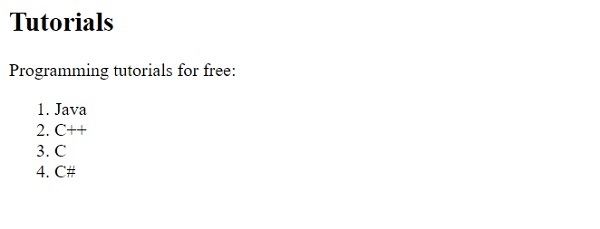HTML标签
HTML中的元素用于描述元数据,即描述、关键字、文档作者等。该元数据不会显示在页面上,但由搜索引擎、网络浏览器等使用。
现在,您还可以在下设置视口来设置网页的尺寸 -
<meta name="viewport" content="width=device-width, initial-scale=1.0">
以下是属性 -
| Sr.No | 类型和描述 |
|---|---|
| 1 | 名称 属性的名称。可以是任何东西。示例包括关键字、描述、作者、修订版本、生成器等。 |
| 2 | 内容 指定属性的值。 |
| 3 | 方案(已弃用) 指定解释属性值的方案(如内容属性中声明的那样)。 |
| 4 | http-equiv 用于http响应消息头。例如,http-equiv 可用于刷新页面或设置 cookie。值包括 content-type、expires、refresh 和 set-cookie。 |
| 5 | 字符集 字符编码。 |
示例< /h2>
现在让我们看一个实现 标记的示例 -
现场演示
<!DOCTYPE html> <html> <head> <meta name="description" content="Learn for free"> <meta name="keywords" content="Video tutorials, free tutorials, learn, web"> <meta http-equiv="refresh" content="20"> <meta name="author" content="Jack Sparrow"> </head> <body> <h2 id="Tutorials">Tutorials</h2> <p>Programming tutorials for free:</p> <ol> <li>Java</li> <li>C++</li> <li>C</li> <li>C#</li> </ol> </body> </html>
输出
这将产生以下输出 -

以上是HTML标签的详细内容。更多信息请关注PHP中文网其他相关文章!

热AI工具

Undresser.AI Undress
人工智能驱动的应用程序,用于创建逼真的裸体照片

AI Clothes Remover
用于从照片中去除衣服的在线人工智能工具。

Undress AI Tool
免费脱衣服图片

Clothoff.io
AI脱衣机

Video Face Swap
使用我们完全免费的人工智能换脸工具轻松在任何视频中换脸!

热门文章

热工具

记事本++7.3.1
好用且免费的代码编辑器

SublimeText3汉化版
中文版,非常好用

禅工作室 13.0.1
功能强大的PHP集成开发环境

Dreamweaver CS6
视觉化网页开发工具

SublimeText3 Mac版
神级代码编辑软件(SublimeText3)
 如何在Go语言中使用正则表达式提取HTML标签内容
Jul 14, 2023 pm 01:18 PM
如何在Go语言中使用正则表达式提取HTML标签内容
Jul 14, 2023 pm 01:18 PM
如何在Go语言中使用正则表达式提取HTML标签内容导读:正则表达式是一种强大的文本匹配工具,它在Go语言中也有着广泛的应用。在处理HTML标签的场景中,正则表达式可以帮助我们快速提取需要的内容。本文将介绍如何在Go语言中使用正则表达式提取HTML标签的内容,并给出相关代码示例。一、引入相关包首先,我们需要导入相关的包:regexp和fmt。regexp包提供
 如何使用Python正则表达式去除HTML标签
Jun 22, 2023 am 08:44 AM
如何使用Python正则表达式去除HTML标签
Jun 22, 2023 am 08:44 AM
HTML(HyperTextMarkupLanguage)是用于创建Web页面的标准语言,它使用标签和属性来描述页面上的各种元素,例如文本、图像、表格和链接等等。但是,在处理HTML文本时,很难将其中的文本内容快速地提取出来用于后续的处理。这时,我们可以使用Python中的正则表达式来去除HTML标签,以达到快速提取纯文本的目的。在Python中,正则表
 PHP如何去除字符串中的HTML标签?
Mar 23, 2024 pm 09:03 PM
PHP如何去除字符串中的HTML标签?
Mar 23, 2024 pm 09:03 PM
PHP是一种常用的服务器端脚本语言,广泛应用于网站开发和后端应用程序开发中。在开发网站或应用程序时,经常会遇到需要处理字符串中的HTML标签的情况。本文将介绍如何使用PHP去除字符串中的HTML标签,并提供具体的代码示例。为什么需要去除HTML标签?在处理用户输入或从数据库中获取的文本时,经常会包含HTML标签。有时候我们希望在显示文本时去除这些HTML标签
 php中怎么转义html标签
Feb 24, 2021 pm 06:00 PM
php中怎么转义html标签
Feb 24, 2021 pm 06:00 PM
在PHP中,可以使用htmlentities()函数来转义html,能把字符转换为HTML实体,语法“htmlentities(string,flags,character-set,double_encode)”。PHP中也可以使用html_entity_decode()函数来反转义html,把HTML实体转换为字符。
 如何在Java中从给定的字符串中删除HTML标签?
Aug 29, 2023 pm 06:05 PM
如何在Java中从给定的字符串中删除HTML标签?
Aug 29, 2023 pm 06:05 PM
String是Java中的final类,它是不可变的,这意味着我们不能改变对象本身,但我们可以更改对象的引用。可以使用String类的replaceAll()方法从给定字符串中删除HTML标签。我们可以使用正则表达式从给定字符串中删除HTML标记。从字符串中删除HTML标签后,它将返回一个字符串作为普通文本。语法publicStringreplaceAll(Stringregex,Stringreplacement)示例publicclassRemoveHTMLTagsTest{&nbs
 HTML中起始标签的示例是什么?
Apr 06, 2025 am 12:04 AM
HTML中起始标签的示例是什么?
Apr 06, 2025 am 12:04 AM
AnexampleOfAstartingTaginHtmlis,beginSaparagraph.startingTagSareEssentialInhtmlastheyInitiateEllements,defiteTheeTheErtypes,andarecrucialforsstructuringwebpages wepages webpages andConstructingthedom。
 如何在HTML表格中使用HTML标签?
Sep 08, 2023 pm 06:13 PM
如何在HTML表格中使用HTML标签?
Sep 08, 2023 pm 06:13 PM
我们可以轻松地在表格中添加HTML标签。HTML标签应放置在<td>标签内。例如,在<td>标签内添加段落<p>…</p>标签或其他可用标签。语法以下是在HTML表格中使用HTMl标记的语法。<td><p>Paragraphofthecontext</p><td>示例1下面给出了在HTML表格中使用HTML标签的示例。<!DOCTYPEhtml><html><head&g
 PHP正则表达式验证基本的HTML标签的方法
Jun 24, 2023 am 08:07 AM
PHP正则表达式验证基本的HTML标签的方法
Jun 24, 2023 am 08:07 AM
PHP是一种高效的网页开发语言,其支持正则表达式功能,能够快速验证输入数据的有效性。在网页开发中,HTML是常见的标记语言,而对HTML标签进行验证,是网页表单验证的一种非常重要的方法。本文将介绍基本的HTML标签验证方法,以及如何使用PHP正则表达式进行验证。一、HTML标签基本结构HTML标签由尖括号包围的元素名称和属性组成,常见的标签包括p、a、div






